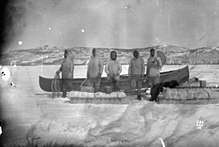Churchill River (Atlantic)
| Churchill River | |
|---|---|
|
Churchill River and waterfalls, Labrador | |
| Native name | (Grand River, Mishtashipu) |
| Country | Canada |
| Physical characteristics | |
| Main source |
Smallwood Reservoir, Labrador 1,550 m (5,085 ft) |
| River mouth | Atlantic Ocean |
| Length | 856 km (532 mi) |
| Discharge |
|
| Basin features | |
| Basin size | 79,800 km2 (30,800 sq mi) |
The Churchill River is a river in Newfoundland and Labrador which flows east from the Smallwood Reservoir in Labrador into the Atlantic Ocean via Lake Melville. The river is 856 km (532 mi) long and drains an area of 79,800 km2 (30,800 sq mi); it is the longest river in Atlantic Canada.
The river is still known locally as Mishtashipu or Mishta-shipu (″Grand River″) by the Labrador Innu and its western section as Patshishetshuanau-shipu by the Central Innu, the peoples of NunatuKavut (Labrador-Metis) and Nunatsiavut, and settlers who identify as Labradorians call it the Grand River.
In 1821, Captain William Martin, in command of HM brig Clinker, took it upon himself to name the river the Hamilton River after the then Commodore-Governor of Newfoundland, Sir Charles Hamilton. On February 1, 1965, the river was renamed the Churchill River by Premier Joey Smallwood, in honour of former British Prime Minister Winston Churchill.
Geography
The river flows in an arc, first north from Ashuanipi Lake though the saucer-shaped Labrador Plateau,[1][2] and then mainly east through a series of lakes.[3] Several of these lakes have been flooded to create the Smallwood Reservoir.[4] The river then flows through a rocky canyon which is hundreds of feet deep, over Churchill Falls, and through a series of rapids below the falls.[5] The water flow in the canyon has been mainly diverted underground through a giant hydroelectric power generating plant.[6] The river continues eastward until it flows into Lake Melville.
Hydroelectric projects
Churchill Falls known by the Central Innu peoples as Patshishetshuanau is the site of a major hydroelectric project, which has a rated capacity of 5,428 MW. Other hydroelectric plants on the river are planned bringing the total to over 9,200 MW. The Churchill Falls development has become a source of friction between two Canadian provinces. The province of Newfoundland and Labrador asserts that Hydro-Québec, which provided a major part of the financing and access to the North American power grid, has taken a disproportionate share of the profits from this development. Hydro-Québec buys power from the Churchill Falls project at rates established in 1969.[6]
U Boat
In 2012 divers using side scan sonar found what they believe is the wreck of a U Boat just downstream of Muskrat Falls, validating a local legend.[7] However, examination of historical records shows this to be unlikely, and the sonar images were quite grainy.[8]
Further reading

- Low, Albert Peter (1896), "Report on explorations in the Labrador peninsula along the East Main, Koksoak, Hamilton, Manicuagan and portions of other rivers in 1892-93-94-95", Geological Survey of Canada, Ottawa: Queen's Printer, retrieved 2010-09-13
See also
References
- ↑ Andrew Hempstead (3 July 2017). Moon Newfoundland & Labrador. Avalon Publishing. p. 165. ISBN 978-1-63121-571-1.
- ↑ Robert Bourassa (1985). Power from the North. Prentice-Hall Canada Incorporated. p. 84. ISBN 978-0-13-688367-8.
- ↑ Fernando de Mello Vianna (17 June 1979). The International Geographic Encyclopedia and Atlas. Palgrave Macmillan UK. p. 161. ISBN 978-1-349-05002-4.
- ↑ María Jesús Hernáez Lerena (18 September 2015). Pathways of Creativity in Contemporary Newfoundland and Labrador. Cambridge Scholars Publishing. p. 257. ISBN 978-1-4438-8333-7.
- ↑ J. Paxton (22 December 2016). The Statesman's Year-Book 1975-76. Springer. p. 266. ISBN 978-0-230-27104-3.
- 1 2 James R. Penn; Larry Allen (2001). Rivers of the World: A Social, Geographical, and Environmental Sourcebook. ABC-CLIO. p. 39. ISBN 978-1-57607-042-0.
- ↑ Brennan, Richard J. (26 July 2012). "German U-boat wreck may be at bottom of Churchill River in Labrador". Toronto Star. Retrieved 31 March 2016.
- ↑ "Group on mission to prove there is truth in legends that Nazi submarines went far inland from Canadian coast". National Post, Tristin Hopper, April 19, 2013
External links
- Canadian Council for Geographic Education page with a series of articles on the history of the Churchill River
- "Churchill River (Labrador)". The Canadian Encyclopedia.
Coordinates: 53°20′58″N 60°10′39″W / 53.34944°N 60.17750°W